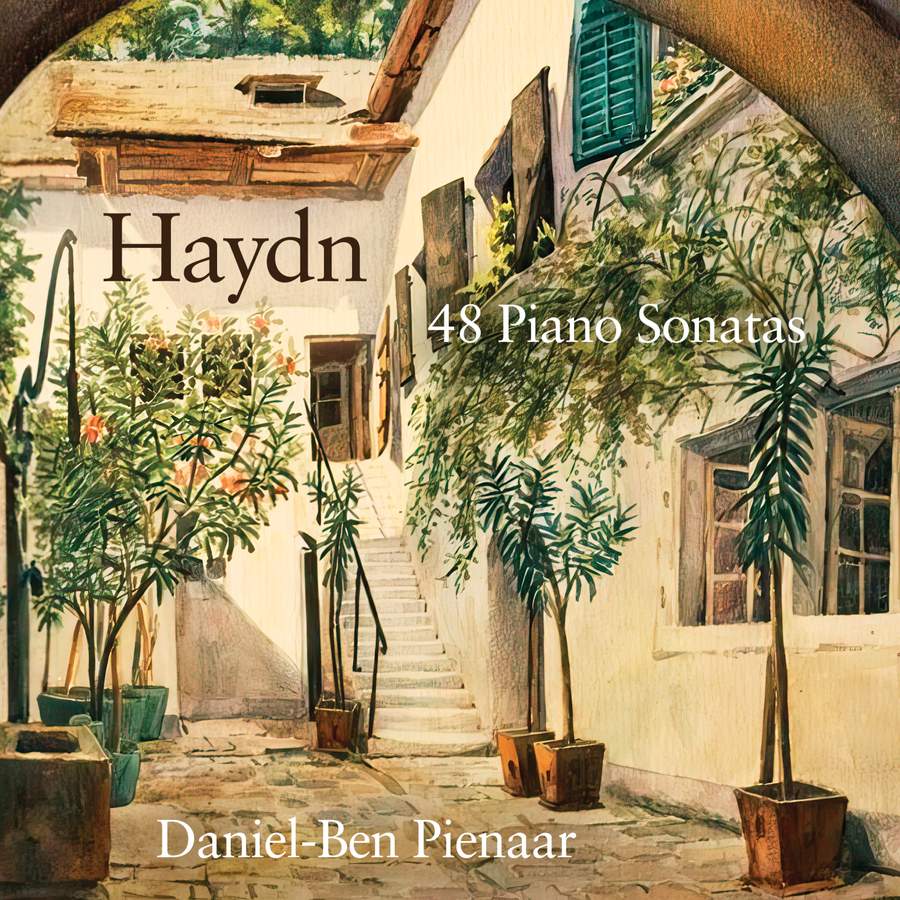HAYDN 48 Piano Sonatas (Daniel-Ben Pienaar)
View record and artist detailsRecord and Artist Details
Genre:
Instrumental
Label: Avie
Magazine Review Date: 10/2023
Media Format: CD or Download
Media Runtime: 578
Mastering:
DDD
Catalogue Number: AV2578

Tracks:
| Composition | Artist Credit |
|---|---|
| 48 Keyboard Sonatas |
Joseph Haydn, Composer
Daniel-Ben Pienaar, Piano |
Author: Jed Distler
Having recorded complete Mozart, Beethoven and Schubert sonata cycles, perhaps it was just a matter of time until Daniel-Ben Pienaar got around to Haydn. The eight discs include the 39 authenticated multi-movement solo keyboard works dating from 1765 onwards titled ‘sonata’, chronologically sequenced by publication date, the nine brief sonatas long presumed to be early works of Haydn plus a bonus in the form of the familiar F minor Variations. The booklet notes cite other early works listed in the Hoboken and Landon catalogues that are either lost, fragmentary or inauthentic.
Many of the early sonatas are modest in size and scope, yet that doesn’t stop Pienaar from lavishing upon them sincere musicality, technical finesse and care over detail. He gives shape and purpose to the ‘strummed’ left-hand chords in the G minor Adagio of HobXVI:6 L13, while spinning out the long right-hand chains of trills with the utmost evenness. While Pienaar rightly feels the D major Menuet and Trio (H4 L9) in one beat to the bar, the basic pulse itself is flexible. The down-beats sometimes slip away due to Pienaar’s over-the-barline phrasing in the finale of the D major H14 L16, yet his timing of the rests foreshadows the mature Haydn’s genius deployment of silences for dramatic effect. There’s also more substance and tragic undertones to the E minor H47bis L19’s opening Adagio than apparent from other recordings, due to the controlled cantabile of Pienaar’s finger legato, the intensity of his dynamic contrasts and his thoughtful deliberation.
Occasionally Pienaar’s creative instincts get the better of him. Myriad caesuras, breath marks, tenutos and taperings make a fussy impact throughout the D major H19 L30’s first-movement Moderato in contrast to, say, Rudolf Buchbinder’s stricter and steadier yet compellingly expressive metrics, yet Pienaar’s brisk finale is as rhythmically centred as one could wish. And although I understood the harmonic intention behind his pressing ahead in the triplet figurations in the A flat H46 L31’s opening Allegro, Emanuel Ax’s slower tempo allows these patterns to emerge in a clearer, better articulated state, where the melodic rise and fall within these patterns more cogently registers. On the other hand, Pienaar compensates with a grippingly spacious slow movement, where time truly stands still. For some reason the slight rushings and angular approach I critiqued in L31’s Allegro prove more convincing in the first movement of the F major H23 L38, but the concluding Presto falls short of Horowitz’s point and crispness.
The cycle’s later and more familiar works often elicit Pienaar’s most inspired interpretations. He breathes fresh and forthright life into the D major H37 L50’s Allegro con brio and takes advantage of the finale’s ma non troppo directive with unexpected accents and dynamic choices. The Presto of the G major H39 L52 goes like the wind but without sacrificing lilting gait. Note, too, the pianist’s uncommon attentiveness to Haydn’s bass lines in the Moderato of the A flat H43 L35. All three movements of the E minor H34 L53 are impeccably judged and proportioned, and what joyous, unabashedly virtuoso outer movements in the C major H50 L60. Such supple and free-flowing fingerwork happily spills over into Pienaar’s unfettered account of the F minor Variations. It sounds closer to a live performance than to a studio recording, and that’s a compliment.
If the wonderful Andante of the C major H48 L58 is a tad square and lyrically reined in, Pienaar’s rollicking Presto is witty to the point of zany: Haydn would have approved! Similarly, there are trade-offs between the two great E flat sonatas. The earlier one (H49 L59) lacks patience and simplicity in the outer movements: Pienaar’s tendency to short-change shorter note values in the Tempo di minuet is an example of what I mean. By contrast, the variations of touch, the variety of arpeggiations and rhetorical specificity throughout H52 L62’s first-movement Allegro elevate this music to the grand scale that it deserves. Perhaps the somewhat opaque small-venue sonic ambience lessens the motoric impact of the finale’s driving repeated-note motif, meaning that the performance may be better than it sounds, to paraphrase Mark Twain’s quip about Wagner’s operas. Indeed, sonic considerations alone lead me to favour Jean-Efflam Bavouzet’s recently completed Haydn cycle as a modern-day reference, together with his more consistent interpretations; I hope Chandos plans to box up the individual discs. Profil’s superbly engineered Haydn cycle showcases Ekaterina Derzhavina’s cultivated, intelligent musicianship and formidable pianistic gifts, and also warrants a serious recommendation. However, Pienaar’s strongest Haydn-playing illuminates the music with personality and a genuine point of view. That’s no small achievement.
Discover the world's largest classical music catalogue with Presto Music.

Gramophone Digital Club
- Digital Edition
- Digital Archive
- Reviews Database
- Full website access
From £8.75 / month
Subscribe
Gramophone Full Club
- Print Edition
- Digital Edition
- Digital Archive
- Reviews Database
- Full website access
From £11.00 / month
Subscribe
If you are a library, university or other organisation that would be interested in an institutional subscription to Gramophone please click here for further information.




